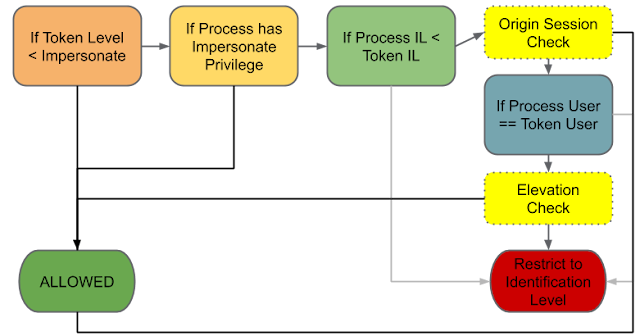
2020-1-30 06:40:0 Author: www.tiraniddo.dev(查看原文) 阅读量:3 收藏
This is just a quick follow on from my last post on Windows Service Hardening. I'm going to pick up on why you shouldn't use a SYSTEM token for a sandbox token. Specifically I'll describe an unexpected behavior when you mix the SYSTEM user and SeImpersonatePrivilege, or more specifically if you remove SeImpersonatePrivilege.
As I mentioned in the last post it's possible to configure services with a limited set of privileges. For example you can have a service where you're only granted SeTimeZonePrivilege and every other default privilege is removed. Interestingly you can do this for any service running as SYSTEM. We can check what services are configured without SeImpersonatePrivilege with the following PS.
PS> Get-RunningService -IncludeNonActive | ? { $_.UserName -eq "LocalSystem" -and $_.RequiredPrivileges.Count -gt 0 -and "SeImpersonatePrivilege" -notin $_.RequiredPrivileges }
On my machine that lists 22 services which are super secure and don't have SeImpersonatePrivilege configured. Of course the SYSTEM user is so powerful that surely it doesn't matter whether they have SeImpersonatePrivilege or not. You'd be right but it might surprise you to learn that for the most part SYSTEM doesn't need SeImpersonatePrivilege to impersonate (almost) any user on the computer.
Let's see a diagram for the checks to determine if you're allowed to impersonate a Token. You might know it if you've seen any of my presentations, or read part 3 of Reading Your Way Around UAC.
Actually this diagram isn't exactly like I've shown before I changed one of the boxes. Between the IL check and the User check I've added a box for "Origin Session Check". I've never bothered to put this in before as it didn't seem that important in the grand scheme. In the kernel call SeTokenCanImpersonate the check looks basically like:
if (proctoken->AuthenticationId ==
imptoken->OriginatingLogonSession) {
return STATUS_SUCCESS;
}
The check is therefore, if the current Process Token's Authentication ID matches the Impersonation Token's OriginatingLogonSession ID then allow impersonation. Where is OriginatingLogonSession coming from? The value is set when an API such as LogonUser is used, and is set to the Authentication ID of the Token calling the API. This check allows a user to get back a Token and impersonate it even if it's a different user which would normally be blocked by the user check. Now what Token authenticates all new users? SYSTEM does, therefore almost every Token on the system has an OriginatingLogonSession value set to the Authentication ID of the SYSTEM user.
Not convinced? We can test it from an admin PS shell. First create a SYSTEM PS shell from an Administrator PS shell using:
PS> Start-Win32ChildProcess powershell
Now in the SYSTEM PS shell check the current Token's Authentication ID (yes I know Pseduo is a typo ;-)).
PS> $(Get-NtToken -Pseduo).AuthenticationId
LowPart HighPart
------- --------
999 0
Next remove SeImpersonatePrivilege from the Token:
PS> Remove-NtTokenPrivilege SeImpersonatePrivilege
Now pick a normal user token, say from Explorer and dump the Origin.
PS> $p = Get-NtProcess -Name explorer.exe
PS> $t = Get-NtToken -Process $p -Duplicate
PS> $t.Origin
LowPart HighPart
------- --------
999 0
As we can see the Origin matches the SYSTEM Authentication ID. Now try and impersonate the Token and check what the resultant impersonation level assigned was:
PS> Invoke-NtToken $t {$(Get-NtToken -Impersonation -Pseduo).ImpersonationLevel}
Impersonation
We can see the final line shows the impersonation level as Impersonation. If we'd been blocked impersonating the Token it'd be set to Identification level instead.
If you think I've made a mistake we can force failure by trying to impersonate a SYSTEM token but at a higher IL. Run the following to duplicate a copy of the current token, reduce IL to High then test the impersonation level.
PS> $t = Get-NtToken -Duplicate
PS> Set-NtTokenIntegrityLevel High
PS> Invoke-NtToken $t {$(Get-NtToken -Impersonation -Pseduo).ImpersonationLevel}
Identification
As we can see, the level has been set to Identification. If SeImpersonatePrivilege was being granted we'd have been able to impersonate the higher IL token as the privilege check is before the IL check.
Is this ever useful? One place it might come in handy is if someone tries to sandbox the SYSTEM user in some way. As long as you meet all the requirements up to the Origin Session Check, especially IL, then you can still impersonate other users even if that's been stripped away. This should work even in AppContainers or Restricted as the check for sandbox tokens happens after the session check.
The take away from this blog should be:
- Removing SeImpersonatePrivilege from SYSTEM services is basically pointless.
- Never try create a sandboxed process which uses SYSTEM as the base token as you can probably circumvent all manner of security checks including impersonation.
如有侵权请联系:admin#unsafe.sh
